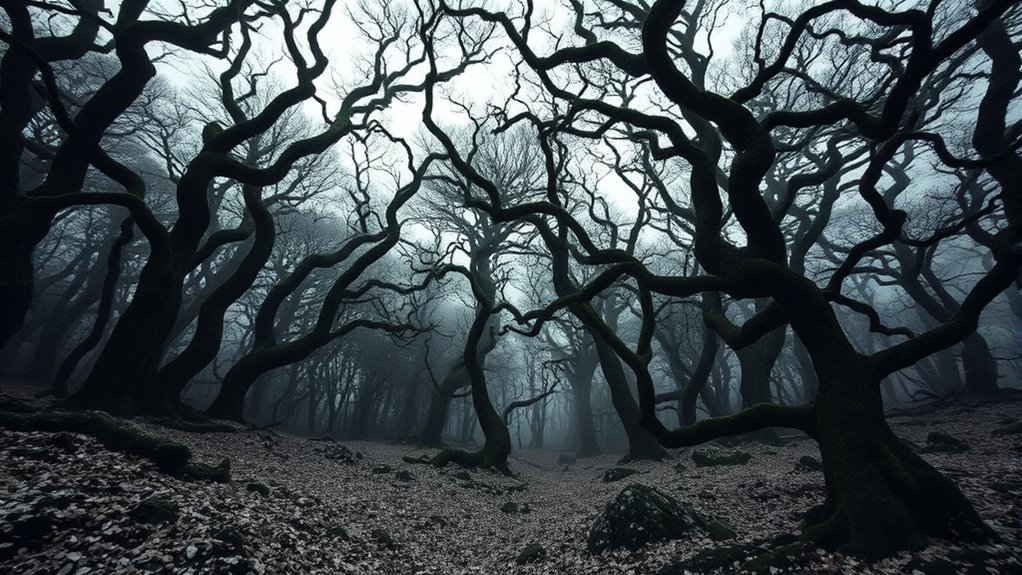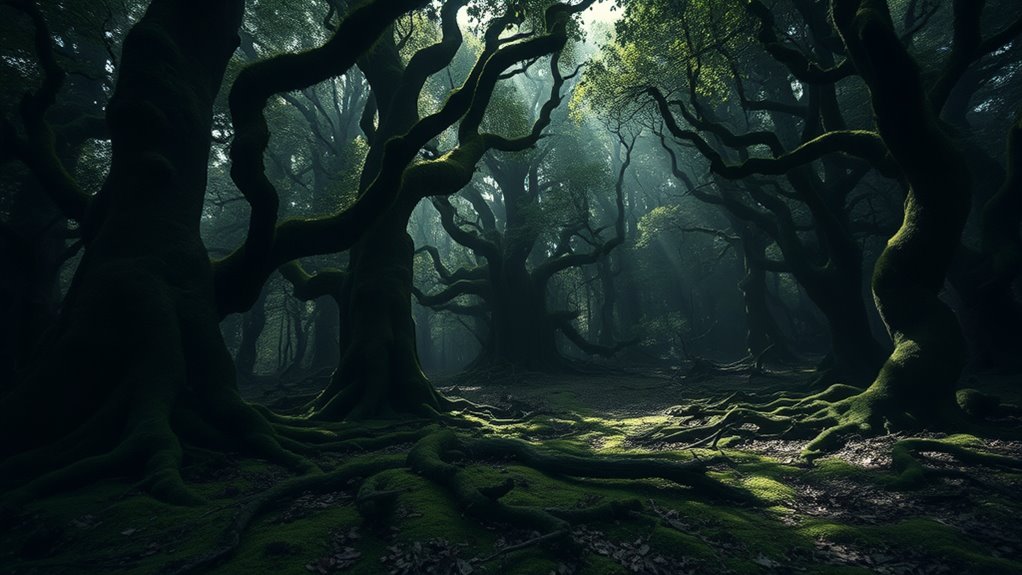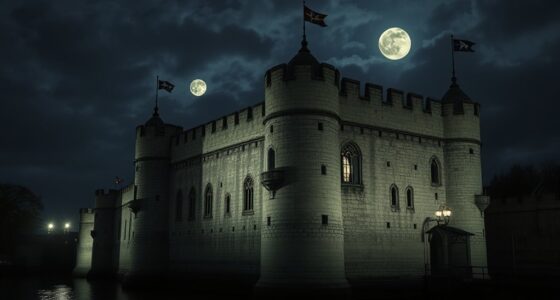Aokigahara Forest, known as Japan’s “Suicide Forest,” is a haunting place where natural beauty hides dark legends and tragic history. You’ll find dense trees, twisted roots, and a quiet atmosphere that feel both calming and eerie. The forest is linked to stories of spirits, ghosts, and curses that have persisted for centuries. Its reputation for tragedy has shaped its mysterious reputation, and if you want to explore more about its history and significance, there’s much more to uncover beyond the surface.
Key Takeaways
- Aokigahara Forest, located at Mount Fuji’s base, is infamous as Japan’s “Suicide Forest” due to its historical association with suicides.
- The forest is steeped in legends of spirits, ghosts, and curses, contributing to its eerie reputation.
- Repeated suicides have caused environmental disturbances, including human remains and debris, impacting local ecosystems.
- Its dense canopy and natural features create a surreal, haunting atmosphere that blends beauty with mystery.
- Efforts are ongoing to prevent suicides, preserve the forest’s natural state, and address the cultural and ecological challenges.

Have you ever heard of Aokigahara Forest, also known as the Sea of Trees? This dense woodland at the base of Mount Fuji is famous for its haunting reputation and mysterious allure. Local legends have long intertwined with the forest’s identity, painting it as a place of both natural beauty and dark folklore. Many stories speak of spirits, yūrei (ghosts), and ancient curses that supposedly haunt the woods, contributing to its reputation as a site where the supernatural and the real collide. These legends have persisted for centuries, fueling curiosity and fear alike. However, the forest’s notoriety isn’t just rooted in myth; it has become globally known as a tragic spot for suicides, which has significant environmental impacts. When people come to the forest with the intent to end their life, it leaves behind more than just sorrow. It affects the delicate ecosystem, disturbing wildlife and causing cleanup efforts that are both emotionally and physically taxing. The repeated presence of human remains and debris can disturb the natural balance, leading to a decline in local flora and fauna. Authorities and volunteers often have to clear the area, which can inadvertently harm the environment. *furthermore*, the psychological toll on those tasked with recovery is profound, highlighting the complex relationship between the forest’s cultural significance and its ecological health.
As you explore Aokigahara, you might notice how the forest’s appearance contributes to its eerie reputation. The dense canopy blocks out much of the sunlight, creating a shadowy, almost surreal atmosphere. The thick moss, twisted roots, and quiet silence lend an otherworldly feel that feeds into local legends. Many visitors feel a strange sense of calm or unease, sensing the weight of stories and tragedies that have unfolded here. Despite its reputation, the forest is also a place of natural wonder, home to unique flora and fauna that have adapted to its quiet, shaded environment. Efforts to preserve its natural beauty are ongoing, even as the forest grapples with its darker history. Local communities and mental health organizations are working to raise awareness about suicide prevention, aiming to address the root causes that lead people to seek solace in such a somber place. Ultimately, Aokigahara is a complex symbol—both a reminder of nature’s resilience and a sobering reflection on human struggles. Its legends and environmental challenges intertwine, making it a place that commands respect, caution, and understanding.
Frequently Asked Questions
Are There Any Safety Measures for Visitors in Aokigahara?
You’ll find safety measures in place when visiting Aokigahara Forest. The park has established visitor guidelines and safety protocols, like marked trails and warning signs, to help keep you protected. Rangers occasionally patrol the area, and there are emergency contact points along the paths. It’s important to follow these guidelines, stay on designated trails, and remain aware of your surroundings to ensure a safe and respectful visit to this unique forest.
What Are the Local Legends Associated With the Forest?
You hear about the local legends surrounding the forest, where superstitions say certain trees are haunted by the spirits of those who passed away. Folklore of yūrei ghosts, restless spirits from Japanese ghost stories, are believed to linger here, adding to its eerie reputation. Many think the forest’s natural beauty is intertwined with these supernatural tales, making it a place shrouded in mystery and superstition that visitors should respect and approach with caution.
How Has Tourism Impacted Aokigahara’S Environment?
You might not realize it, but your visit to Aokigahara impacts its fragile environment. Ecotourism effects can lead to increased foot traffic, disturbing wildlife and damaging plant life. Conservation challenges arise as efforts struggle to balance visitor curiosity with preservation. Every step you take leaves a mark, making it essential to follow responsible practices. Your awareness can help protect this mysterious forest from further harm, ensuring its secrets endure for generations.
Are There Support Services Available for Those Struggling Mentally?
If you’re struggling mentally, support services are available to help you. You can access mental health resources and crisis helplines that provide immediate assistance and guidance. These services are designed to support those in distress, offering a safe space to talk and find solutions. Remember, you’re not alone, and reaching out for help is a brave step toward feeling better and getting the support you deserve.
What Is the Forest’s Significance in Japanese Culture?
Silent, sacred, and steeped in symbolism, Aokigahara holds a special place in Japanese culture. You’ll find it’s more than just a forest; it’s a site of spiritual significance and cultural symbolism. Many see it as a place to reflect and reconnect with nature. Its eerie aura echoes Japan’s complex relationship with death, remembrance, and reverence, making it both a somber symbol and a spiritual sanctuary.
Conclusion
As you explore Aokigahara Forest, remember it’s estimated that around 100 people visit annually, some seeking solace, others lost in despair. This haunting forest’s reputation as Japan’s “suicide forest” reminds us of the importance of mental health awareness. While its eerie silence is unsettling, it also offers a chance to reflect on compassion and support for those struggling. By understanding its history, you can appreciate the delicate balance between nature’s beauty and human vulnerability.









